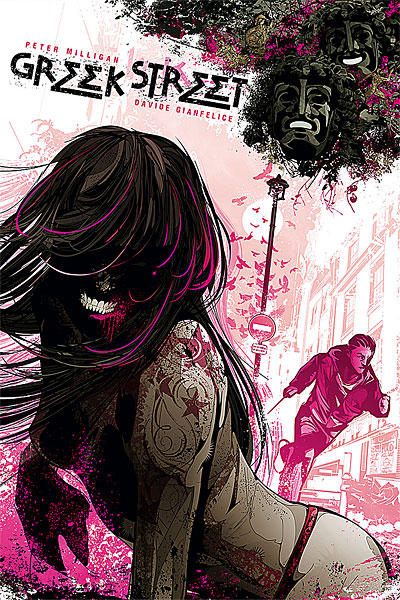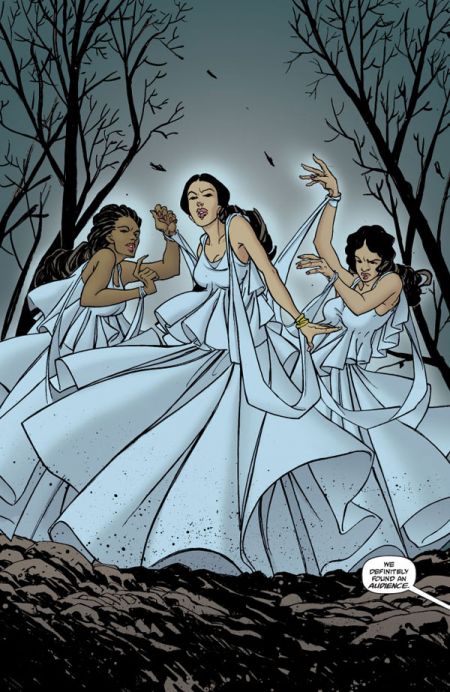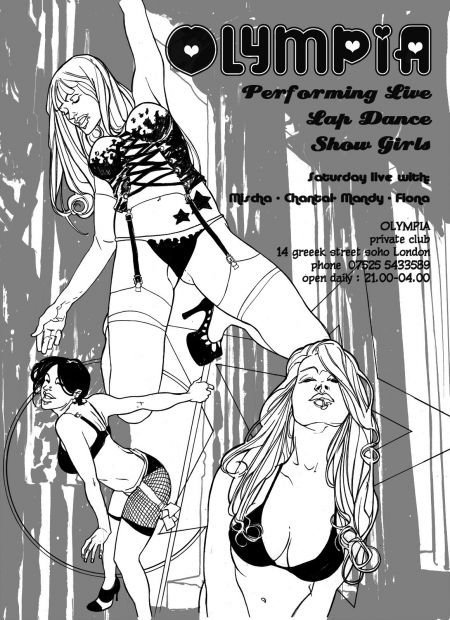Greek Street #1
By Andy Frisk
July 2, 2009 - 00:51
DC Comics
Writer(s): Peter Milligan
Penciller(s): Davide Gianfelice
Inker(s): Davide Gianfelice
Colourist(s): Patricia Muluihill
Letterer(s): Clem Robins
Cover Artist(s): Clem Robins
ISBN: Kako
$1.00 US
While there has been much, well deserved, hype surrounding Vertigo’s new series The Unwritten, Peter Milligan’s new series,

The new series is set in modern day London, against the backdrop of Soho, “that infamous district,” and its streets of “Wardour, Great Windmill, and Greek”. To quote Milligan in Vertigo’s monthly On The Ledge column, Greek Street recounts the tale of Oedipus Rex, and the tale of Cassandra, among others, using characters wittily named Eddie, Sandy, and the like. Presiding over the tale, and speaking up to inform readers on themes and events, much like the chorus does in many classic Greek plays, is a group of strippers known as the “Chorus Girls” who dance in Olympia, a Greek Street club. Their boss, and Olympia club owner, Mr. Furey, hints through his name, that the girls might even double as the classic furies of ancient Greek mythology at some point.

The Chorus Girls in more traditional dress.
The greatest aspects of this new series, judging from its great debut, is that it is a crime noir tale in the vein of The Sopranos and that, although it’s a reworking of the aforementioned Greek myths and tragedies, the reader doesn’t have to be an expert on, or for that matter even familiar with, them to follow and enjoy the unfolding tale. An understanding and familiarity with the tragedies and myths, though, makes the tale come alive with a vigor that’s as intoxicating as the fumes of the Delphic Oracle, and as gritty as a
Milligan firmly sets his reworking of these tragedies and myths in the modern world, but there are hints of the supernatural at work as well. By supernatural, I mean discounting its whimsical connotation, something more along the lines of the power of myths and their truths, which still haunt us to this day and materialize in the stories of everyday people around us again and again. This, more aptly, sums up the “supernatural” aspect of the series, as these stories and characters return to us again and again, like ghosts of their former incarnations. It is the repetition of the human story, with all its triumphs and tragedies that give literary truth to the allegorical tales of human failings and accomplishment which these myths represent. A monologue by one of the Chorus Girls during the opening sequence, which is quite masterfully, even cinematically, laid out (and if Greek Street is ever adapted to film, should be recreated word for word, and shot for shot), explains the series’ theme best: "This is the old dance. This is the old story. You see, these old stories aren’t through with us. No matter how many different names or masks we might wear… They’re not finished with us yet… I’m thinking about recurrences. What you might call eternal recurrences. Running through the generations like... like blood. We think our science means we’re different or better than we used to be. We think we’re making progress. Every

Promo Art: Phony ad for The Olympia Club
Gianfelice’s art captures the mix of myth, and real world grittiness quite well, creating players, scenes, dress, and stage backdrops that fit their role, and reveal aspects of their character, yet are never out of the realm of the appearance of someone you might pass on the street. He also creates horrifying images of dream and vision sequences, which are inhabited by the recently deceased and more hideous monsters. All the while though, his art never goes over the top or wildly out of proportion to real life.
Overall, the feel of this book, even in its earliest stages, is reminiscent of Vertigo’s Sandman. The dreamy, yet shockingly realistic atmosphere, coupled with the interaction of myth, story, and the everyday, as well as the literary allusions, of
Rating: 10/10
Related Articles:
Vertigo Comics from DC Comics September 2013
Vertigo Comics for June 2013
@Vertigo_Comics Announces Crossover
Arrow Vertigo Review
The Binquirer, Post-Con Edition: The future of Waid's Thrillbent, new Marvel movies, Neil Gaiman's return to Vertigo, and much more!
Comic Con: Neil Gaiman Reteams with Vertigo for Sandman Mini
Cowboys (Vertigo Crime)
Brightest Day #24 (and the De-Vertigo-ing of Swamp Thing)
Rat Catcher (Vertigo Crime)
Vertigo Resurrected: The Extremist
